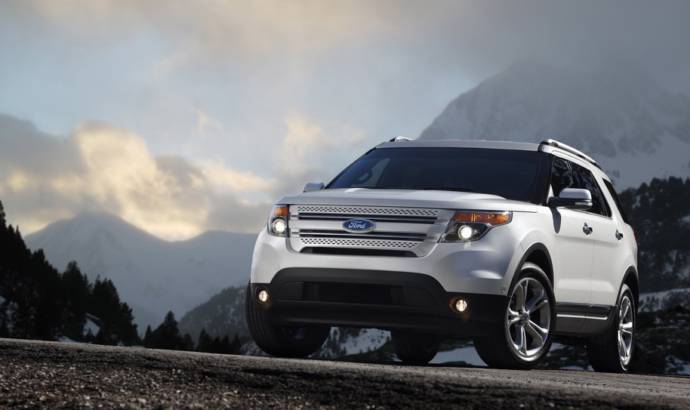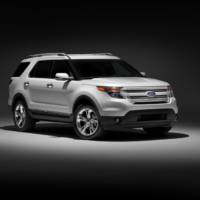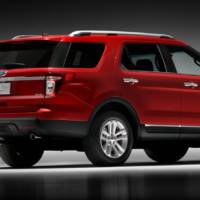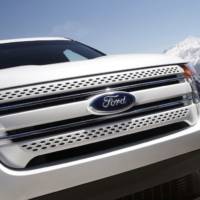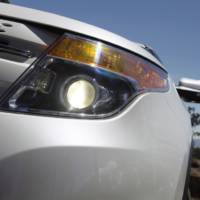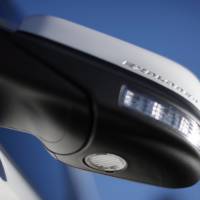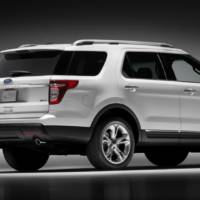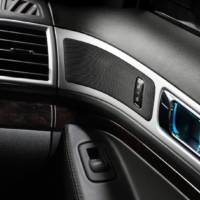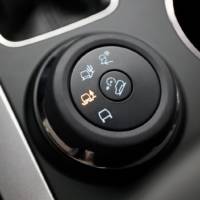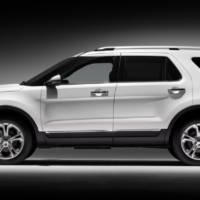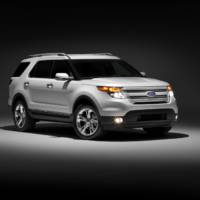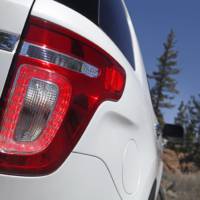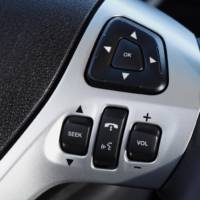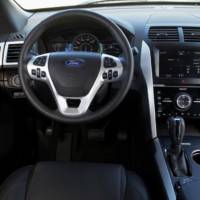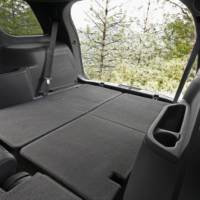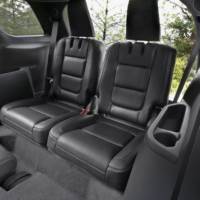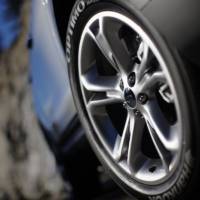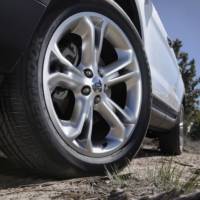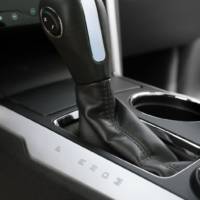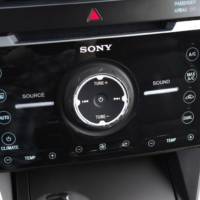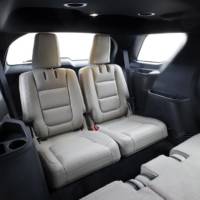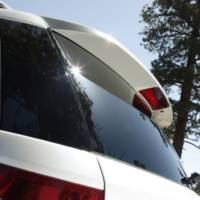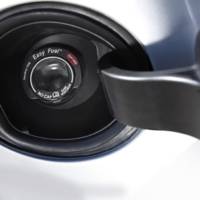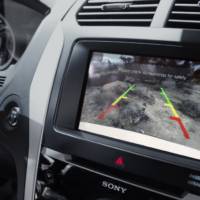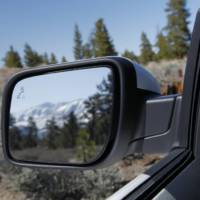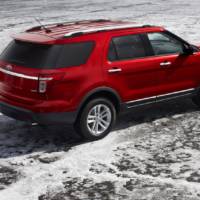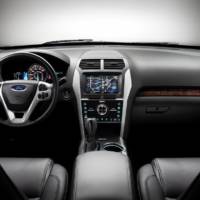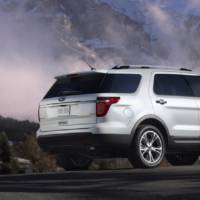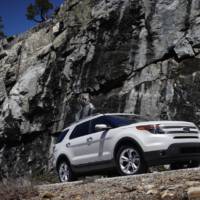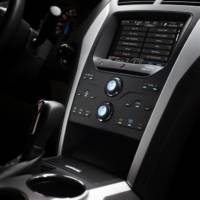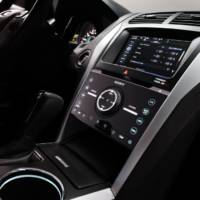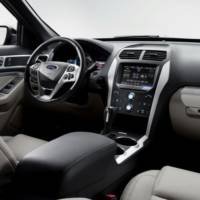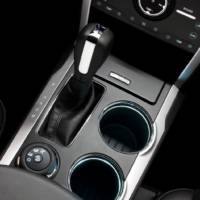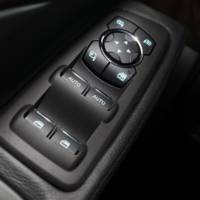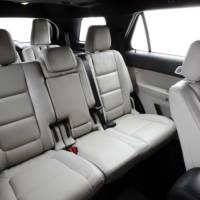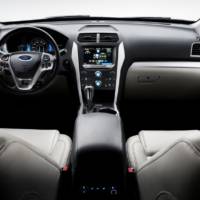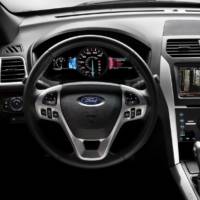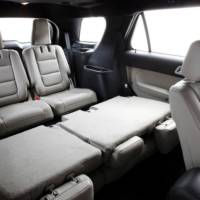The 2011 Ford Explorer was finally revealed by the Blue Oval, with complete details and plenty of photos which show that the company’s new generation SUV has been taken to a new level.
The 2011 Ford Explorer will be offered in three equipment levels (base, XLT and Limited) and under the bonnet customers will find the new 3.5-litre V6 that is 20 percent more fuel efficient than the current Explorer and which produces 290 HP and 255
lb-ft of torque.
The second powering option available is the 2.0-litre I-4 naturally aspirated V6 that packs 237 HP @ 5,500 rpm and 250 lb-ft of torque that will make the 2011 Ford Explorer as fuel efficient as a 2010 Toyota Camry V6 sedan.
As far as transmission the 2011 Ford Explorer will use a 6-speed automatic on the base version while the XLT and Limited models feature the SelectShift Automatic with steering wheel mounted toogle switches.
At the interior the 2011 Ford Explorer makes use of higher quality materials while some of the safety features include 2nd generation first-row airbags, side seat airbags, SOS Post-Crash Alert System, Energy-management system pretensioning, Safety Canopy, Adaptive cruise control and collision warning with brake support and others.
Standard equipment on the 2011 Ford Explore includes a 4.2-inch LCD screen part of the MyForddriver system, air filtration, media hub, cruise control, power windows and door locks, the Easy Fuel capless fuel filler system, four 12 volt power points and cargo hooks.
The 2011 Ford Explorer price was not announced yet.
Ford press release:
DEARBORN, Mich., July 26, 2010 – Ford’s iconic Explorer has been
reinvented and redeveloped to create new expectations for SUV fuel
efficiency and performance. It will be the new class leader in its
segment with fuel economy improvements reaching more than 30 percent.
“This all-new Explorer adds class-leading fuel efficiency to a
legendary portfolio of capability, performance and customer
convenience,” said Jim Holland, chief nameplate engineer. “SUV customers
in general – and Explorer customers specifically – told us they want
the freedom and empowerment Explorer always has stood for, with improved
performance and significantly increased fuel economy.”
Offering two new engines – the technologically advanced
turbocharged, direct-injection four-cylinder that is the latest in the
Ford Motor Company EcoBoost commitment and a responsive, fuel-efficient
V6 – the new Explorer balances capability with environmental
responsibility.
Explorer V6 sets new standard
The Explorer 3.5-liter V6 is offered as standard equipment across
base, XLT and Limited models. Delivering an anticipated improvement in
fuel economy of more than 20 percent versus the current Explorer, this
smooth and powerful V6 enables intelligent four-wheel drive (4WD) with
terrain management. The improvement in efficiency helps Explorer to
surpass fuel economy figures for the 2010 Honda Pilot and other vehicles
in the segment.
Using Ti-VCT for optimized fuel economy and reduced part-throttle
emissions, this engine delivers an estimated 290 horsepower and 255
lb.-ft. of torque.
This V6 engine has been highly developed for the Explorer
application, with multiple actions that enhance mechanical efficiency,
increase fuel economy, lower emissions, reduce operating costs and
bolster durability.
Mechanical efficiency, performance and fuel economy have been
improved through Ti-VCT, a low-tension drive belt featuring a one-way
clutch for the alternator, a direct-acting mechanical bucket (DAMB)
valvetrain with polished buckets to reduce friction, piston-cooling
jets, improved bay-to-bay breathing through the cylinder block and
composite cam covers that reduce engine weight.
Ti-VCT allows precise, variable control of valve overlap, or the
time when intake and exhaust valves are open concurrently. This enables
increased mechanical efficiency for improved response and performance,
while optimizing fuel economy. In part-throttle conditions, Ti-VCT helps
reduce emissions.
The 3.5-liter V6 also features improved deceleration fuel shutoff
technology to maximize fuel economy in closed-throttle situations.
The Explorer V6 has been engineered for durability with a
chain-driven camshaft, high-strength forged powder metal connecting rods
with floating pins, fully counterweighted forged steel crankshaft, a
die-cast aluminum deep-sump oil pan and four-bolt main bearing caps with
side bolts through the engine block.
Noise, vibration and harshness (NVH) characteristics are controlled
and reduced through a tuned composite upper and lower manifold, the
silent-chain cam drive and an acoustic engine cover.
The Explorer 3.5-liter V6 delivers best-in-class fuel economy yet offers power to tow up to 5,000 pounds when properly equipped.
EcoBoost 2.0-liter I-4 delivers normally aspirated V6 punch
For SUV drivers seeking maximum fuel efficiency, Ford introduces
the all-new Explorer with an available EcoBoost2.0-liter I-4. Combining
direct injection of gasoline and turbocharging, this advanced engine
delivers performance comparable to normally aspirated competitive V6
engines. Developing up to 237 horsepower at 5,500 rpm, this I-4 delivers
250 lb.-ft. of torque.
Estimated fuel economy improves by more than 30 percent, putting
the fuel efficiency of the Ford Explorer in line with sedans such as the
2010 Toyota Camry V6.
Like other Ford EcoBoost engines, peak torque is generated at a low
1,700 rpm across a broad band to 4,000 rpm. This torque plateau makes
for flexible, efficient power delivery across a wide range of engine and
vehicle speeds, while helping save fuel by making power at lower rpm
levels. Ti-VCT, four valves per cylinder and DAMB valve lifters increase
mechanical efficiency through improved engine breathing across the
broad power and torque bands.
A relatively high compression ratio is enabled by the use of direct
gasoline injection, operating at fuel pressures from 2,200 to 2,800
psi. The unique turbocharger is optimally matched to the EcoBoost I-4
engine and SUV vehicle performance behavior. Precise fuel pressure
control allows the Explorer I-4 to deliver boosted power at low rpm,
without annoying turbo lag.
The EcoBoost I-4 uses 5W30-GF4 oil to reduce friction and reduce cost of ownership through 10,000-mile oil change intervals.
Targeted durability is 10 years, or 150,000 miles. Durability
actions include enhanced oil filtration and cleanliness, the addition of
an aluminum oil cooler with improved heat dissipation and cast
inter-bore cooling inside the aluminum engine block. This engine
represents the initial U.S.-market application of the brick-style
charge-air cooler, delivering increased thermal efficiency.
The new 2.0-liter EcoBoost engine is being introduced globally by
Ford Motor Company, with applications in various products in Europe,
Asia and Australia, in addition to the new Explorer.
EcoBoost technology will serve as a key element in Ford’s global
sustainability efforts, powering up to 1.3 million vehicles on an annual
basis by 2013.
Six-speed transmissions help performance and economy
The unique six-speed transmission paired with each Explorer offers
performance and economy advantages with the flexibility of optimum
gearing for every situation. Lower gears provide the benefit of improved
acceleration from a full stop, while higher gears help increase fuel
economy by allowing the engine to operate at lower speeds when cruising.
Explorer XLT and Limited models offer a SelectShift Automatic™ transmission, allowing drivers to manually change gears using a shifter-mounted +/- toggle switch.
Explorer powertrains have been developed to provide SUV drivers
with the power and capability they expect and deserve, coupled with the
fuel economy they really want.
DEARBORN, Mich., July 26, 2010 – Ford Explorer – the vehicle that
defined a segment – has been completely reinvented, raising customers’
expectations of sport utility vehicle (SUV) fuel efficiency, safety,
technology, capability and quality.
“The all-new Explorer will deliver today’s SUV buyers the
attributes they really want and value, and a few they might not even
have dreamed of,” said Mark Fields, Ford president of The Americas.
“We’re proud to introduce the new Explorer to customers and fans around
the world today and pleased to begin a whole new era that blends strong
SUV fuel economy and performance.”
The all-new Explorer launches today to its Facebook friends in a
unique social media initiative, followed by reveal events throughout the
U.S. and Canada.
Shattering SUV fuel economy and performance expectations
“The new Explorer simply does everything well,” said Derrick Kuzak,
group vice president, Global Product Development. “It raises the bar
for ride and handling on the road and transforms the off-road
experience. It’s the hands-down winner for towing capability and ease.
All this capability – and three rows of seating – with amazing fuel
economy will make Explorer the absolute right choice for families with a
sense of adventure.”
The 2011 Explorer with V6 power is expected to deliver more than 20
percent better fuel economy than the 2010 model, shattering
conventional expectations for SUV fuel efficiency. When equipped with
the available 2.0-liter EcoBoost™ I-4 engine, Explorer fuel
economy is expected to improve by more than 30 percent and exceed the
2010 Honda Pilot and 2010 Toyota Highlander V6.
Chief Nameplate Engineer Jim Holland said the team targeted two key objectives when developing the 2011 Ford Explorer.
“It had to look modern and contemporary – inside and out – yet be
instantly recognizable as an Explorer,” said Holland. “Next, the new
Explorer needed to deliver the fuel economy today’s customers want,
combined with the performance, capability and empowerment they expect
from an SUV.”
Driven by the commitment to give customers unsurpassed fuel
efficiency with each new vehicle, Ford attacked every detail to
transform Explorer with significantly improved fuel economy:
- Twin independent variable camshaft timing (Ti-VCT)
- Latest Ford EcoBoost engine
- Six-speed automatic transmissions
- Electric power-assisted steering (EPAS) to significantly reduce parasitic power loss
- Intelligent four-wheel drive (4WD)
- Variable-displacement air-conditioning compressor
- Optimized tires for reduced rolling resistance
- Slippery aerodynamics with harmonized front air dam and rear liftgate spoiler
Weight reduction is a key element in improving Explorer fuel
efficiency. While adding significant content to the vehicle, engineers
were able to reduce total vehicle weight by almost 100 pounds through
the use of lighter materials such as an aluminum hood. Explorer weight
loss is even more impressive, as the latest versions of Honda Pilot and
Toyota 4Runner have added pounds versus previous models.
Explorer’s available advanced 2.0-liter EcoBoost I-4 delivers the
power of a normally aspirated V6 without compromising four-cylinder fuel
economy. Aimed at the SUV buyer whose top priority is fuel economy,
this turbocharged and intercooled I-4 engine delivers a projected 237
horsepower at 5,500 rpm and 250 lb.-ft. of torque from 1,700 through
4,000 rpm. The EcoBoost employs direct injection of gasoline, Ti-VCT,
direct-acting mechanical bucket (DAMB) valve lifters and four valves per
cylinder.
Explorer’s standard powertrain combines front-wheel drive with a
3.5-liter Ti-VCT V6 engine, delivering an estimated 290 horsepower and
255 lb.-ft. of torque. Ti-VCT allows individually optimized camshaft
timing of valve opening and closing events to improve mechanical
efficiency while delivering increased power and reducing part-throttle
emissions. Mated to a six-speed automatic transmission, this powerful,
flexible and efficient V6 is projected to deliver more than 20 percent
better fuel economy versus the previous Explorer V6 model.
Explorer’s variable-displacement air-conditioning compressor
provides a fuel economy benefit with less drag and smoother transition
for improved driveability.
Each Explorer engine is paired with a unique six-speed automatic
transmission, combining lowered initial gears for improved off-the-line
acceleration and higher gearing for improved efficiency at lower engine
rpm when cruising.
Explorer V6 models are available with an intelligent 4WD system
that adds terrain management. Situation-selectable, this powertrain
advancement takes the guesswork out of 4WD range choice.
A driver need only turn the console-mounted knob to the proper
setting among snow, sand, mud and normal modes. This system also
includes a hill descent mode.
Simpler and more convenient for SUV veterans, the system will be a confidence-builder for drivers new to the segment.
Contemporary design with segment-leading craftsmanship and quietness
In addition to its clean, modern design inside and out, Explorer
aims to please SUV shoppers with a thoughtful, flexible interior package
that abounds with clever storage capacity. The new SUV features more
head and shoulder room, three rows of flexible seating, and room for
everything families want to take along on their adventures.
The Explorer design – inside and out – is executed with world-class
craftsmanship. Tight margin gaps are just one indication of the immense
attention to detail applied to craftsmanship across the spectrum, from
design to engineering to manufacturing.
The Chicago facility where Explorer will be produced raised the bar
on initial quality measures with the recent Taurus launch, which is
good news for customers.
“Crafting a high-quality vehicle is like preparing a gourmet meal,”
said Peter Bejin, craftsmanship supervisor. “You start with
high-quality ingredients, execute your recipe with flawless preparation
and finally, present it with flair and panache.”
Quietness – another profound advancement in the all-new 2011 Ford Explorer – also will signal quality to customers.
The team enhanced noise, vibration and harshness (NVH) control for
the all-new Explorer using an advanced technology called NoiseVision. A
ball with hundreds of tiny cameras and microphones, NoiseVision allows
engineers to pinpoint and address potential noise issues earlier in the
development process.
Explorer is expected to be superior to in-segment competitors and rival premium SUVs in quietness and NVH control.
Explorer safety – strength, technology and innovation
The all-new Explorer targets top safety ratings with a stiff
unibody structure and a class-leading suite of active and passive safety
features and technologies, plus another Ford safety innovation – the
world’s first second-row inflatable rear belts.
Rear seat passengers – often children or mature passengers – can be
more vulnerable to head, chest and neck injuries. Ford’s unique
inflatable rear belts spread impact forces across more than five times
the area than conventional seat belts, reducing pressure on the chest
while helping to control head and neck motion. Belt comfort should also
help increase usage rates. Studies show inflatable belts to be more
comfortable for passengers due to padding.
From the boron front bumper beam through the hydroformed front
frame rails and high-strength steel side-impact tubes, Explorer’s rigid
body structure is designed to provide robust protection for occupants.
In the instance of a crash, these elements come together to protect
Explorer driver and passengers inside a safety cage of strength.
Standard Explorer safety features include:
- AdvanceTracwith RSC features Curve Control functionality to provide braking – optimized by each individual wheel
- Second-generation first-row airbags, side seat airbags
- Belt-Minder® for driver and first-row passenger
- Front passenger sensing system
- Energy-management system pretensioning for height-adjustable first-row seat belts
- LATCH (Lower Anchors and Tethers for CHildren) system for outboard second-row positions, for safely securing child safety seats
- SOS Post-Crash Alert System™
- Safety Canopy® side curtain airbags
- Tire Pressure Monitoring System
Available Explorer safety features include:
- Adaptive cruise control and collision warning with brake support
- BLIS® (Blind Spot Information System) with cross-traffic alert
Stretching the breadth of capability
The 2011 Ford Explorer redefines customer expectations for driving
dynamics and comfort – on any road, anytime, anywhere – while stretching
the breadth of SUV capability. Transforming Explorer’s driving quality
was central to creating an SUV for 21st century customers.
“Our objectives for Explorer dynamics were threefold,” said Carl
Widmann, vehicle engineering manager. “The first element was to greatly
increase on-road comfort, capability and driving dynamics. The second
was to maintain the ‘any road, anytime, anywhere’ capability of the
previous model. Finally, we aimed to apply technology to the task of
safely towing, as V6 Explorer models are rated up to 5,000 pounds. We
think customers will be pleased with the next-generation Explorer on all
three counts.”
The theme of the all-new Explorer dynamics development was balance.
The team sought to provide an engaging driver experience in harmony
with the extended breadth of 4WD capability to build driver confidence.
The shift to a unibody construction platform enabled a reduction in
road noise and significantly decreased Explorer body roll in dynamic
cornering situations. Independent front suspension is of the short- and
long-arm configuration with a 32-millimeter front stabilizer bar.
Independent rear suspension is the SR1 configuration, so-named for its
one-to-one shock absorber ratio, which enables precise ride control.
Explorer’s EPAS system allows for variable rates of assistance
based on speed, turn-in and direction. In addition to optimized steering
feel, tight on-centering and appropriate resistance, EPAS provides a
fuel economy benefit in comparison to traditional hydraulic power assist
systems. EPAS also enables a competitive turning radius for optimum
maneuverability in parking situations, combined with increased
assistance at low speeds for parking ease.
EPAS allows for the addition of Curve Control, a new feature that
senses when a driver enters a turn too quickly and applies brake
pressure to stabilize the vehicle.
In addition, EPAS enables the optional active park assist
technology. When activated, the system scans for a suitable spot,
calculates the trajectory, and steers the vehicle. The driver continues
to control brake and throttle inputs, but the system steers the vehicle
throughout the parking maneuver.
Off-roading standout on a variety of surfaces
The key to Explorer 4WD capability is Ford’s new terrain management system.
Replacing the traditional SUV transfer case configuration, the new
system takes the guesswork out of maximizing 4WD and the capabilities it
enables. Rather than employment of four-high, four-low and auto
settings, Explorer terrain management is selectable by situation. The
four settings – available by shift-on-the-fly – include normal, mud,
sand and snow.
Each setting provides unique engine behavior, throttle tip-in,
transmission shift scheduling and calibrations for traction and
stability control systems. Terrain management also includes Hill Descent
Control™, which provides engine braking to increase driver confidence and control when descending a steep incline.
Explorer models with V6 power are rated to tow a maximum of 5,000
pounds. To aid with hookup – especially when alone – a reverse camera
with zoom-in functionality is available, allowing a driver to back up to
the trailer on-center. The Explorer towing package includes trailer
sway control – a stability package shared with the Ford F-150 pickup –
to help minimize trailer sway. Trailer brake controller wiring is also
included, as is a tow/haul mode. Engaging tow/haul mode increases engine
braking to help slow the vehicle and trailer when descending steep
grades.
Loaded with features, convenience and connectivity
The all-new Explorer is available in three trim series levels –
base, XLT and Limited. Each offering presents a robust array of standard
features, with a class-leading selection of additional convenience and
connectivity options so a buyer can tailor a new Explorer to his or her
individual needs and desires.
Standard convenience features include:
- MyForddriver connect technology including 4.2-inch LCD screen
- MyKey™ owner control feature
- Air filtration system
- Media hub
- Easy Fuel® capless fuel filler system
- Cruise control
- Power windows, with one-touch down for driver
- Power door locks with child safety rear door locks
- Tilt/telescoping steering column
- Four 12-volt power points
- Cargo hooks
Explorer XLT includes standard content and adds:
- Automatic headlamps
- Six-speed SelectShift Automatic™
- Heated sideview mirrors with LED signal indicators and security approach lamps
- SecuriCode™ keyless entry keypad
- Reverse sensing system
- Perimeter alarm
Explorer Limited includes all base and XLT content, plus:
- PowerFold® sideview mirrors with driver’s side memory
- Ambient lighting
- Adjustable pedals with memory functionality
- Cargo net
- Dual-zone electronic temperature control
- 10-way power driver’s seat, with power recline and lumbar
- Electrochromic interior mirror
- Rear view camera
- Remote start system
- 110-volt outlet
- MyFord Touchdriver connect technology
- Intelligent Access with push-button start
- Universal garage door opener
“We spent our time listening to customers and addressing their
needs to launch an SUV that reinvigorates the Explorer nameplate and
delivers on Ford’s promise of high-quality, fuel-efficient and
technologically advanced vehicles with industry-leading safety,” said
Holland. “The all-new Explorer will change market perceptions about SUV
style, fuel efficiency, technology and user-friendliness.”
The 2011 Explorer will be assembled at Ford’s Chicago manufacturing
facility. Production begins late this year, and Explorer will be
available in dealerships this winter.

